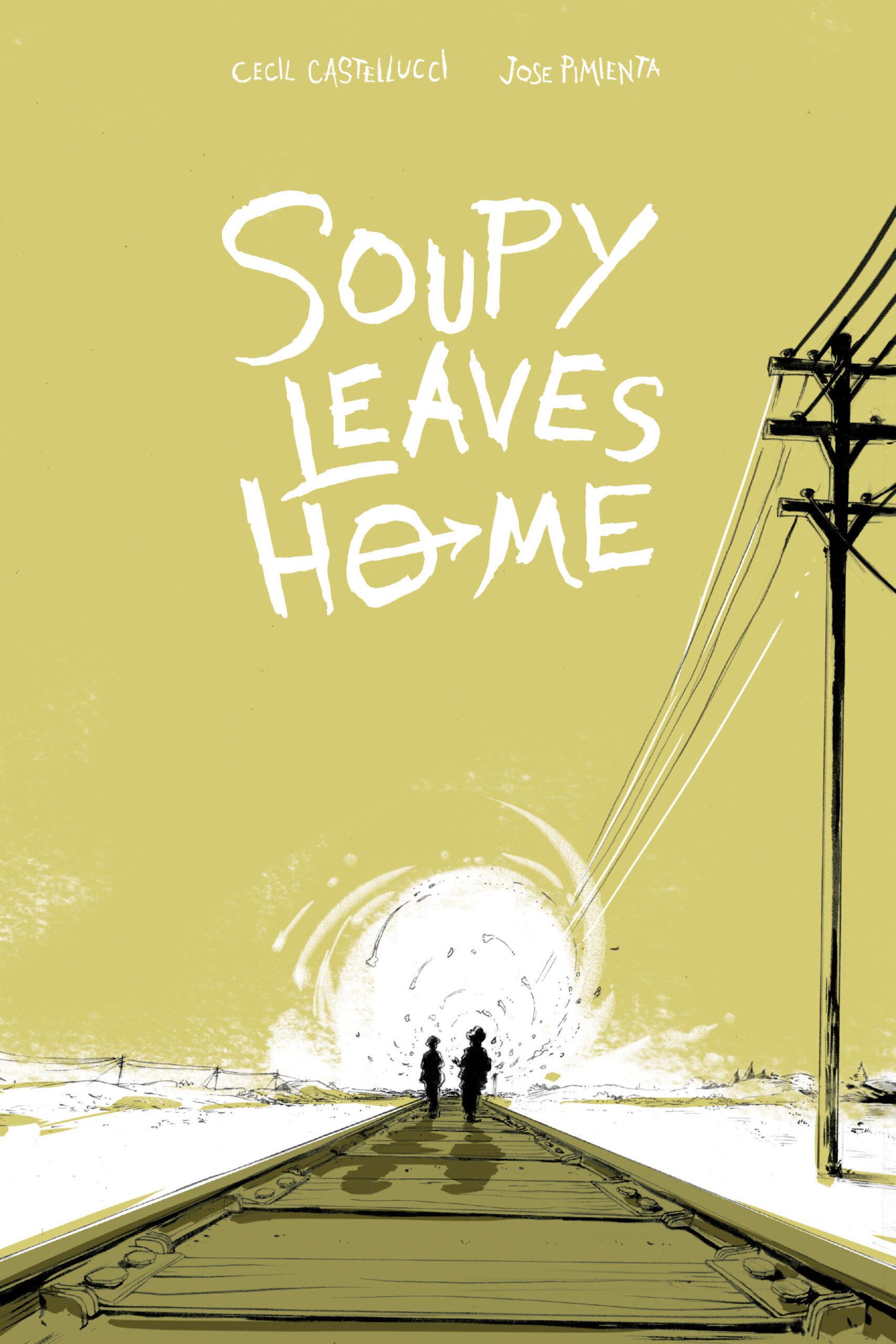
The artistic oeuvre of Cecil Castellucci is dauntingly varied and vast. A singer/songwriter, a playwright, a librettist, she is also the author of many books, ranging from the picture book Grandma’s Gloves (winner of the California Book Award Gold Medal) to the YA novels Boy Proof, Tin Star, and the part comic, part prose novel The Year of the Beasts.
An American-Canadian, Castellucci is a two-time MacDowell Fellow, and the founding YA Editor at the Los Angeles Review of Books. Her work often is a meditation on themes of being an outsider and how art can save. She started her comic book career with The Plain Janes, which launched the beloved but sadly defunct DC Comics Minx line. She garnered an Eisner nomination for her charming comic for kids, Odd Duck. She now writes the critically acclaimed Shade, the Changing Girl comic for DC Comic’s Young Animal line. With her latest graphic novel, Soupy Leaves Home, Castellucci delves into the myth of the hobo, the power of the imagination, and riding the rails.
***
The Rumpus: What came first, a girl striking out on her own, or the promise of riding the rails?
Cecil Castellucci: It’s really hard to say. They both sort of emerged at the same time. I saw someone on Facebook post what they thought their hobo name would be and people were commenting and I thought to myself, “I’d be a girl named Soupy.” I was going through a really dark time, living at my parent’s house after escaping a psychologically abusive relationship that really sideswiped me. I didn’t know how to heal, despite the fact that I was getting good and steady care. When I thought of my hobo name, and about a girl named Soupy leaving and hitting the road in a bygone era, I suddenly saw a way forward for me. It was slow going, I dreamt Soupy up in 2008, so it’s been a long journey from initial spark to this beautiful book. But as I started to think of Soupy and started to think about how she would be on the road and what the promise of leaving her life and riding the rails would give her space and room for, I had something to cling to. To concentrate on. To see how Soupy could go from shut down and quiet and bruised inside and out to someone who became wholly herself. She was like training wheels for me when I couldn’t or didn’t want to be me. Of course, after a few years, she became her own thing and had her own story, which was very different than mine. But I think the fundamental thing was how she left in order to come home. Which I think many hoboes did.
Rumpus: Did trains play a big part of your past and do they hold a special place in your present?
Castellucci: Yes. I have always loved train travel. I remember taking the train up to Montreal and it was during the Olympics. I was in the observation lounge and everything was beautiful. There were some Olympians going up to compete and they taught me to play Crazy Eights and I the whole atmosphere was so social and fun with the world rushing by. After that, we went to Europe and stayed on a sleeper car and I think that was when I was hooked. I have taken many of the cross-country lines here in the states and I really want to take them all. Also, I want to do the Cross Canada and the cross every country everywhere on the planet. I think that train travel is romantic and dreamy. It does seem as though the slowness of it and the rocking of the cars on the rails evoke something beautiful. Something unhurried that seems lost in these breakneck times.
Rumpus: What is it about the hobo narrative that most appeals to you?
Castellucci: There are so many things that appeal to me. I think the fact that it is a group of people who roam from place to place. Who have a shadow society that is outside of what is considered normal society. Who live in a kind of freedom from the world and its constraints. Who have a strict code of ethics that they try to live by—the Hobo Code is pretty amazing. Who have a secret language of signs. Who have to handle being judged harshly and are misunderstood and therefore really have to see into the hearts of others.
Rumpus: The book is very romantic and idealistic—do you think you’re glamorizing what life as a hobo must have been like?
Castellucci: Ha. Yes. It is pretty romantic and idealistic. I mean, I do show some rough parts, but I guess I do it in a soft way. Bulls doing raids on trains were pretty scary. The constant trouble that the jungles had from the people who didn’t want jungles in their town was probably exhausting. The slamming of doors and the constant judgment was relentless. Trying to find work, trying to find food, trying to find shelter. The road was dangerous, which is why many girls dressed as boys. It was not an easy life. I did do a lot of research. Read a lot of books. Watched some documentaries and some films that depicted hobos. You can quickly see that it wasn’t romantic. It was tough.
Rumpus: Best train journey you’ve taken?
Castellucci: I really love the Coast Starlight. It goes from Los Angeles to Seattle. I’ve been told it’s the most beautiful and luxurious of all the American Rail lines. Although I heard that they recently took out their fancy double deck bar car, which had a movie theater in the lower part. It was so beautiful, staring at the coastline and sitting in this truly gorgeous old-timey car. Recently I was in the UK and I just loved being able to train it everywhere. The answer is probably really, every train journey, because it’s all about what’s outside the window and how the day-dreaming goes.
Rumpus: Is there a Ramshackle tucked away in your life somewhere?
Castellucci: I think that there is a Ramshackle in everyone’s life, different people who help and guide you during rough times or big life moments. I suppose one person is my honorary Godfather Jacques d’Amboise. He was a ballet dancer with the New York City Ballet and I met him when I was twelve and surly and awkward and he saw something in me that he recognized. That I was an artist like he was and throughout the years he’s just been this magical person in my life who has steadily encouraged me on my artistic journey. We’re still friends, he just sent me an email response to a letter I wrote him about a new project I’m working on. He looks at the world and sees art and possibility and beauty and dance. When you have coffee with him, you see the potential in every idea. It’s pretty wonderful. What I love about Ramshackle, too, is that he is a man out of time. Or before his time. He dreams of a future that the characters can’t quite picture but he can see. I love the way that Jose Pimienta drew Ramshackle’s way of seeing the world. A bit of magical realism with the vision of an inventor. A man who can see the possibilities ahead.
Rumpus: When writing a graphic novel how do you leave space for the artwork, and are there moments in the story you count on the artwork to tell the story (or at least enhance it) wordlessly?
Castellucci: When I am writing a comic, I write a script. With Shade the Changing Girl and DC Comics stuff, I do full script, which means that I break down panel and pages. But with Soupy Leaves Home I did open script, which means that I broke down to pages, but I did not break down panels. I left that to Jose Pimienta, to do the panel and pacing (I did this with Nate Powell in our book Year of the Beasts as well.) I find that with both kind of scripts, but more so with open script, I tend to overwrite dialogue a bit. In this way I am giving the dramatic pacing to the artist who then finds the flow. When I get the thumbnails/pencils back, I end up throwing out about half of those words because it’s all there on the page. It’s pretty amazing. It’s like the words are scaffolding and then you can remove them and have silence. That’s what comics do best, and what you can’t do in a prose novel. Silence and quiet. Wordless pages in comics are a breath and a pause for the reader. And they convey things that words are too clumsy to say. So in a way, yes, I do leave space for that, because I am always certain that I am going to look for moments where I can delete words.
Rumpus: We’ve both written historical fiction about the difficulties young women face pursuing their dreams. How has that struggle evolved for the twenty-first century girl?
Castellucci: I could say that in the past, for a girl like Soupy, the sexism seems very clear. She likes to read, she wants to go to school and her Father doesn’t want her to and her family thinks these things are improper for a girl. But that struggle is still very real today. I think it’s evolved into being tougher and a struggle in a sneakier way. Sure we girls can wear pants now, and vote, and go to college, have a bank account, get a job that is not just stewardess or nurse. But we still have to deal with micro-aggressions and daily sexism. We are still fighting for word over our own bodies. We still get the short shrift on equal pay. We’re still not represented in media or the arts with total parity. Not on screen or on the page or behind the scenes. We still are discouraged from pursuing STEM careers. It’s still not easy. There is still this constant low-grade fight to be seen and taken seriously when you are a girl and when you become a woman. It totally sucks. I think in historical fiction it just seems a more obvious injustice and struggle.
***
Author photograph © Eric Charles.





